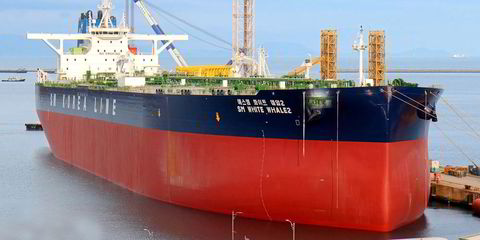Panamax bulker spot rates have done something since the beginning of February that they usually do not do.
They have outperformed capesize rates, which have fallen 56% since 20 January amid seasonality and weather-related mining disruptions in Brazil and Australia.
The panamax 5TC, a weighted average of spot rates on five key routes, on 2 February rose to $14,615 per day while its capesize counterpart fell to $14,053 per day.
Panamax spot rates did fall slightly to $14,669 per day on Tuesday but still beat capesize rates by $2,612 per day, according to Baltic Exchange assessments.
"It is unusual for panamaxes to earn more than capesizes and more unusual for the paper on panamaxes to trade above capesizes," John Kartsonas, founder of Breakwave Advisors, told TradeWinds.
"It has happened in the past, especially during first quarters, but it's not often at all."
Panamax rates were often above those for capesizes during last year's first quarter, coming in as much as $7,222 per day higher on 9 March versus $2,385 per day for capesize rates.
Catching up after the first quarter
But capesize rates eventually surpassed their panamax counterpart by $554 per day on 14 April by reaching $7,915 per day, falling below panamax rates just a few more times in 2020.
Those rare days include 14 May when panamax rates came in at $5,524 per day versus $1,992 per day for capesizes and 28 May when panamaxes earned $6,483 per day on average against $3,228 per day for capesizes.
Panamax rates outpaced capesize rates again on 8 December, earning $1,488 per day more by attaining $12.095 per day.
Capesize rates have fallen markedly since late January for several reasons, including this week's Chinese New Year celebrations and rainy seasons in Australia and Brazil, said Rebecca Jones, research analyst for London broking house Alibra Shipping.
"Finally, this could be a reaction to the cooling measures put in place in China back in December to calm on-shore iron-ore price rises," she told TradeWinds.

Smaller ships enjoy higher exposure to global economy
Rates for more numerous panamaxes and other smaller vessels are probably getting a lift, however, amid greater exposure to the global economy and congestion in South America, Kartsonas said.
"I think the combination of stronger economic activity globally, high congestion and strong coal flow are helping smaller size ships," he told TradeWinds.
"On the other hand, capesizes are suffering from slower iron-ore exports out of Brazil."
Capesize rates are going through a seasonal decline and should rally above panamax rates when the market normalises in March, he said.
Capesize spot rates may stay subdued to September amid the traditional seasonality, Cleaves Securities analyst Joakim Hannisdahl said.
Brazil's monthly iron-ore exports are expected to come in at 22m tonnes for February, down 24% from January's total, he said.
"Smaller vessel segments often fare better during the first half of the year, supported by the agricultural season from around March until May."
"This year could of course be different, with Covid-19 impacting traditional seasonal patterns for dry-bulk commodity consumption, inventories and thus demand for transportation."







